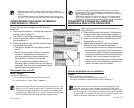
French_69
69_English
interface USB
Ce chapitre présente les raccords vers un ordinateur pour effectuer différentes fonctions.
- Pour raccorder un câble USB sur un ordinateur, reportez-vous aux instructions d’installation du
logiciel et aux caractéristiques techniques de l’ordinateur.
CONFIGURATION SYSTÈME
Transfert d’une image numérique par le biais d’une connexion USB
Le caméscope numérique prend en charge la fonction USB 2.0 à haut débit. (en
fonction des spécifi cations de l’ordinateur).
Vous pouvez transfrére un fi chier enregistré sur le support de stockage vers un
ordinateur par le biais d’une connexion USB.
Si vous transférez des données sur un ordinateur, vous devez installer le logiciel
(pilote DV, Codec vidéo, DirectX 9.0) compris avec le caméscope numérique.
Débit de la connexion USB en fonction du système
La connexion USB à haut débit est prise en charge par les
pilotes de périphérique Microsoft (Windows) uniquement.
Windows 2000 – Connexion USB à haut débit sur un ordinateur
équipé de Service Pack 4 ou d’une version plus récente.
Windows XP – Connexion USB à haut débit sur un ordinateur
équipé de Service Pack 1 ou d’une version plus récente.
Windows Vista – Connexion USB à haut débit sur un ordinateur
équipé de Service Pack 1 ou d’une version plus récente.
Besoins du système
Systèmes d’exploitation Windows
UCT : Intel® Pentium 4™, 2 GHz + ou équivalent
Systèmes d’exploitation : Windows® 2000/XP/Vista
Installation standard Si vous avez récemment mis votre sytème d’exploitation à
jour, nous ne pouvons garantir le fonctionnement adéquat de ce produit.
Mémoire : RAM de 512 Mo ou +
Disque dur : 2 Go ou +
Résolution : 1024x768 points, couleur 24 bits
Port USB : USB 2.0 haut débit
- Nous vous conseillons la confi guration des systèmes mentionnée plus haut.
Selon votre système, le fonctionnement n’est pas garanti même s’il rencontre les
normes de confi guration.
- Le caméscope numérique est reconnu comme périphérique de stockage
amovible par les ordinateurs Macintosh.
(Mac OS 10.3 ou ultérieur peut accueillir la norme USB à haute débit standard)
•
•
•
•
•
•
•
•
•
•
•
•
•
USB interface
This chapter explains how to connect a PC using the USB cable for various actions.
- To connect an USB cable to a PC, refer to the software installation instructions
and available PC specifi cation.
SYSTEM REQUIREMENTS
Transferring a Digital Image through a USB Connection
The memory camcorder supports USB 2.0 High speed.
(Depends on the PC specifi cation)
You can transfer a recorded fi le in storage media to a PC via a USB connection.
If you transfer data to a PC, you need to install the software (DV Driver, Video
Codec, DirectX 9.0) supplied with the memory camcorder.
USB Connection Speed (depending on the System)
High speed USB connection is supported by Microsoft (Windows) device drivers
only.
Windows 2000 - High speed USB on a system with Service Pack
4 or later installed.
Windows XP - High speed USB on a system with Service Pack 1
or later installed.
Windows Vista - High speed USB on a system with Service Pack
1 or later installed.
System Requirements
Windows operating systems
CPU: Intel® Pentium 4™, 2GHz or higher, or the equivalent
Operating systems: Windows® 2000/XP/Vista
Standard installation is required. If you have upgraded your current operating
system, we can not guarantee
the proper operation of the product.
Memory: 512MB RAM or higher
Hard Disk: 2GB or higher
Resolution: 1024x768 dots, 24bit color
USB port: USB2.0 High Speed
- System requirements mentioned above are recommendations. Even on a system that
satisfi es the requirements may not ensure the operation depending on the system.
- This memory camcorder is recognized just as a removable storage device on the
Macintosh computer. (Mac OS 10.3 or above supporting the High Speed USB
standards)
•
•
•
•
•
•
•
•
•
•
•
•
•


















